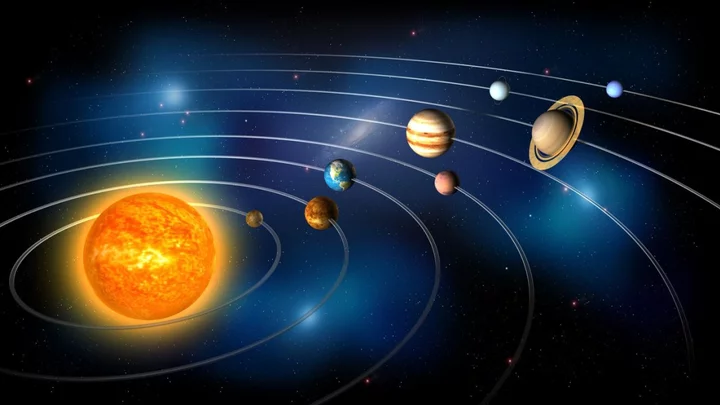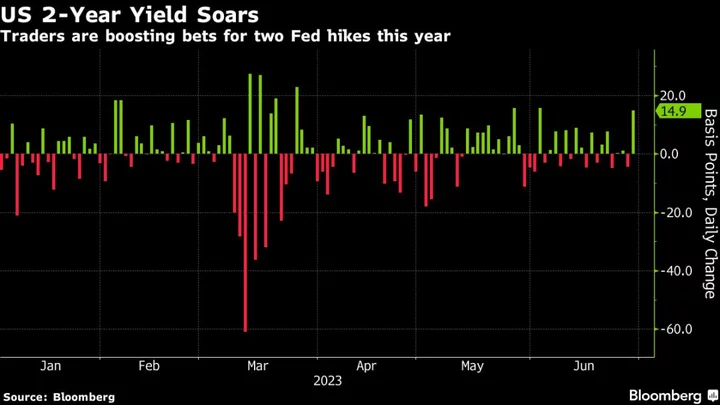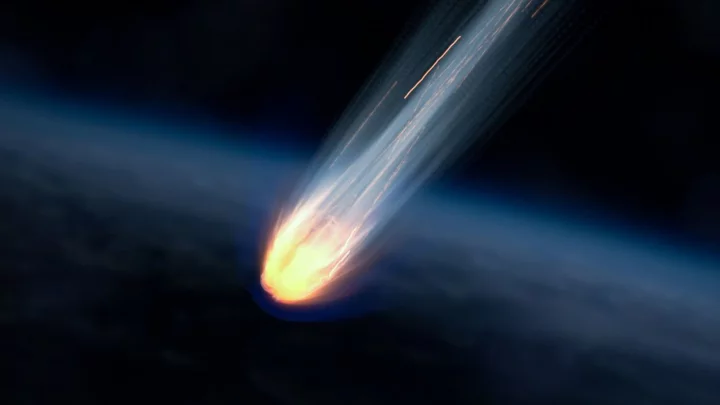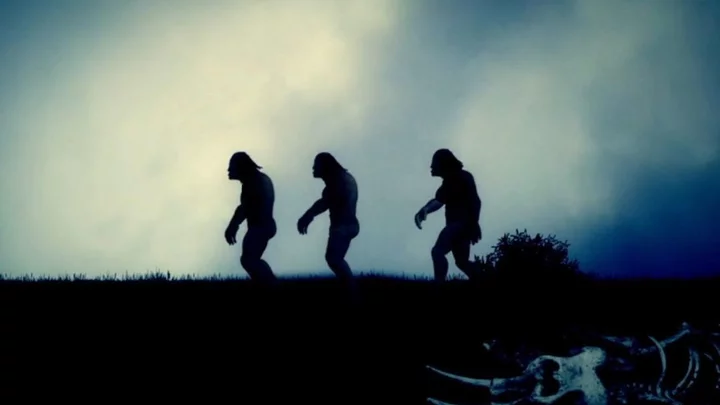
Ukraine Recap: CIA Chief Burns Calls War ‘Corrosive’ for Putin
The invasion of Ukraine has had a “corrosive” effect on President Vladimir Putin’s regime and Russian society, William
2023-07-02 17:55

Ukraine Recap: Zelenskiy Renews Warning of ‘Act’ at Atomic Plant
Ukrainian President Volodymyr Zelenskiy repeated a warning that Russia plans a “terrorist act” at the Zaporizhzhia nuclear power
2023-07-01 22:49

South Korea’s Export Drop Eases, Suggesting Bottom Is Near
South Korea’s export slump eased further in June, suggesting that weakness in global demand may be moderating. Headline
2023-07-01 08:56

Fidelity Leads Flurry of Bitcoin ETF Refilings to Answer SEC
In a flurry of Friday afternoon activity, Fidelity Investments led a handful of firms that filed a fresh
2023-07-01 07:16

China Pilots Steps to Lure Foreign Firms to Free-Trade Zones
China rolled out a number of measures to open up its free-trade zones as state leaders go on
2023-06-30 16:45

Scientists discover secret planet hidden in our solar system
There are eight planets in our solar system – plus poor old Pluto, which was demoted in 2006 – but what if there were more? Turns out that might be the case. Astronomers have calculated there is a 7 per cent chance that Earth has another neighbour hiding in the Oort cloud, a spherical region of ice chunks and rocks that is tens of thousands of times farther from the sun than we are. “It’s completely plausible for our solar system to have captured such an Oort cloud planet,” said Nathan Kaib, a co-author on the work and an astronomer at the Planetary Science Institute. Sign up to our free Indy100 weekly newsletter Hidden worlds like this are “a class of planets that should definitely exist but have received relatively little attention” until now, he said.. If a planet is hiding in the Oort cloud, it’s almost certainly an ice giant. Large planets like Jupiter and Saturn are generally born as twins. They have huge gravitational pulls of their own, however, and sometimes destabilise one another. That could have led to a planet to be nudged out of the solar system entirely – or exiled to its outer reaches, where the Oort cloud resides. “The survivor planets have eccentric orbits, which are like the scars from their violent pasts,” said lead author Sean Raymond, researcher at the University of Bordeaux’s Astrophysics Laboratory. That means that the Oort cloud planet could have a significantly elongated orbit, unlike the near-perfect circle Earth tracks around the sun. Trouble is, when things are that far away, they’re pretty difficult to spot. “It would be extremely hard to detect,” added Raymond. “If a Neptune-sized planet existed in our own Oort cloud, there’s a good chance that we wouldn’t have found it yet,” said Malena Rice, an astronomer at MIT not involved in this work. “Amazingly, it can sometimes be easier to spot planets hundreds of light-years away than those right in our own backyard.” Time to crack out the telescope. Have your say in our news democracy. Click the upvote icon at the top of the page to help raise this article through the indy100 rankings.
2023-06-30 15:26

Facebook urged to suspend strongman leader over video threatening violence
The oversight board for Facebook's parent company Meta Platforms on Thursday said Cambodian Prime Minister Hun Sen should be suspended from the social media site for six months for posting a video violating rules against violent threats.
2023-06-30 14:50

Asia Stocks Set for Muted Open After Bond Selloff: Markets Wrap
Asian stocks were set for a mixed open to the last day of the quarter on Friday following
2023-06-30 06:52

US lawmaker urges labelling, restrictions on AI content
WASHINGTON U.S. Senator Michael Bennet, a Democrat who is active in artificial-intelligence issues, wrote to leading tech firms
2023-06-30 00:54

'Alien spacecraft' found at the bottom of Pacific Ocean
For years people have been looking to the skies for signs of alien life - but maybe, they should have been looking at the bottom of the ocean this whole time. A Harvard physicist has claimed that parts of an alien 'spacecraft' could have been uncovered under the sea. Professor Avi Loeb set off on a search along the bottom of the Pacific Ocean and found 50 iron pieces which originated from the IM1 meteor. IM1 crashed off the coast of Papua New Guinea and Leob believes it could contain key information in the search for life out there in the universe, saying he hasn’t discounted the idea of the pieces being evidence of a “spacecraft” from an “extraterrestrial technological civilization” which crashlanded on Earth. Sign up to our free Indy100 weekly newsletter Loeb is currently the head of Harvard’s Galileo Project, focusing on the search for aliens, and he said the fragments they found must have come from “a natural environment different from the solar system, or an extraterrestrial technological civilization.” Speaking to Fox News Digital, Loeb detailed his thoughts on the origins of the meteor fragments by saying: “Given IM1's high speed and anomalous material strength, its source must have been a natural environment different from the solar system, or an extraterrestrial technological civilization.” He added that IM1 “is actually tougher and has material strength that is higher than all the space rocks that were catalogued by NASA. That makes it quite unusual.” Have your say in our news democracy. Click the upvote icon at the top of the page to help raise this article through the indy100 rankings.
2023-06-29 21:27

Everybody alive today came from one African country, according to study
It’s well known that all humans alive today can be traced back to a common ancestor but a study may have found where that ancestor originates. Researchers at the University of Oxford’s Big Data Institute mapped the entirety of genetic relationships among humans to create the largest human family tree ever. By combining modern and ancient human genomes data from eight different databases, the researchers were able to create a massive family tree. This allowed them to see how a person’s genetic sequence relates to another using the points of the genome. Sign up for our free Indy100 weekly newsletter “Essentially, we are reconstructing the genomes of our ancestors and using them to form a vast network of relationships,” Lead author Dr Anthony Wilder Wohns said. “We can then estimate when and where these ancestors lived.” Where they lived? Sudan, Africa. Dr Wohns told Reuters, "The very earliest ancestors we identify trace back in time to a geographic location that is in modern Sudan. “These ancestors lived up to and over 1 million years ago—which is much older than current estimates for the age of Homo sapiens—250,000 to 300,000 years ago. So bits of our genome have been inherited from individuals who we wouldn’t recognize as modern humans," Dr Wohns said. Researchers used 3,609 individual genome sequences from 215 populations and samples that ranged from 1,000s to over 100,000 years. By using a new method to compile the data, algorithms were able to predict where common ancestors were in evolutionary trees to explain some patterns of genetic variation. The results were a network of almost 27 million ancestors. “The power of our approach is that it makes very few assumptions about the underlying data and can also include both modern and ancient DNA samples,” Dr Wohns says. Not only does the data help us understand human geology better but the new method could help in other research, like medicine. “The underlying method could have widespread applications in medical research, for instance identifying genetic predictors of disease risk," Dr Wohns added. Have your say in our news democracy. Click the upvote icon at the top of the page to help raise this article through the indy100 rankings.
2023-06-29 18:21

Stephen Hawking theory proved right by man-made black hole
Scientists have managed to simulate their very own black hole in their lab and witnessed how it began to glow. The black hole event horizon was created by a team of physicists from the University of Amsterdam, who used a chain of atoms in a single file to gain further understanding about the behaviour of a black hole. Its creation managed to prove Stephen Hawking's theory from 1974 where the black hole emitted a rare form of radiation. Sign up to our free Indy100 weekly newsletter They studied the properties of Hawking radiation through the creation of a black hole analog in the lab. According to Science Alert, Hawking radiation happens when "particles born from disturbances in the quantum fluctuations caused by the black hole's break in spacetime." The fact that the radiation exhibits a glow itself is in a strange space anomaly, as the event horizon of a black hole is supposed to be where neither light nor matter is able to get out. We all learn about the strength of a black hole in science class – and how we would all be inevitably sucked in as a result. This is possible due to its density within a certain range of the centre, so even an attempt at travelling beyond light speed (or any velocity in the universe for the matter) would not make this unavoidable. The fake black hole event also caused a rise in temperature that matched theoretical expectations of an equivalent black hole system, - but only when part of the chain extended beyond the event horizon, Science Alert reported. As a result, it is believed perhaps this entanglement of particles that straddle the event horizon plays a big role in generating Hawking radiation. Under simulations that began by mimicking spacetime thought of as "flat," scientists say the radiation was only thermal for a certain range of 'hop amplitudes'. So there may be certain situations where Hawking radiation can emit thermally - and could only be the case where gravity causes a change in the warp of space-time. "This can open a venue for exploring fundamental quantum-mechanical aspects alongside gravity and curved spacetimes in various condensed matter settings," the scientists wrote in their paper published by Physical Review Research. Have your say in our news democracy. Click the upvote icon at the top of the page to help raise this article through the indy100 rankings
2023-06-29 18:19
